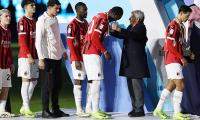Hillhouse who claimed she had not relied on Johnson for her sourcing. That raises the possibility that straight after the Abbottabad raid someone in the US was talking to bloggers in an attempt to put out the alternative narrative that Hersh finally gave such prominence to four years later.
Next unanswered question: what have the relatives who were in the compound at the time of the attack got to say? It was striking that after Bin Laden’s death the relatives were held by the Pakistani authorities which apparently gave the US either no or very limited access. They were subsequently sent to Saudi and Yemen and have disappeared without trace. A decent-sized scoop awaits the journalist who can find one of them.
Was there a walk-in and if so who was it? Of all of Seymour Hersh’s claims, the most convincing was that there was a walk-in. There have long been rumours that someone did collect some or all of the $25m reward money and some possible names have been put forward. I once chased a story that a Pakistani security type turned arms dealer, responsible in particular for a helicopter deal, went missing after the raid. Once a regular on the Islamabad party circuit attended by mid ranking to senior officers in Islamabad, he simply disappeared. There was talk that he had moved to the US. The sources were authoritative but I could find no trace of the gentleman in US – possibly, his Pakistani friends suggested, because he was in witness protection.
There are different versions of what information a walk-in many have handed over. Take the recent claims from NBC. Initially the news organisation seemed to back Hersh up when it quoted two intelligence sources saying that a walk-in asset from Pakistani intelligence told the CIA where Bin Laden was hiding. But NBC subsequently amended its story to say that the walk in did not know the location but rather simply provided useful information that helped the US in its search.
There are also a couple of points about Bin Laden’s stay in Pakistan that neither Hersh nor the official accounts mention at all.
In 2012 the BBC published a story that Bin Laden, in the summer of 2010, attended a dinner in the tribal areas. Senior sources in Washington told me at the time of publication that they believed that account to be correct. If so it raises issues about how Bin Laden could have been moved from Abbottabad in what was apparently a large convoy of vehicles without the state officials becoming aware.
Finally and perhaps most intriguingly, what happened to Hamza bin Laden? Recently released documents from the bin Laden compound described the efforts Al-Qaeda made to move Hamza bin Laden from Iran to Abbottabad.
Hours after the Bin Laden killing an ISI source told me that the organisation believed one of Bin Laden’s sons had been captured by the US and taken away with the father’s body in the helicopter. In other words a son was missing. Subsequently it was reported that that Hamza bin Laden was not in the compound at the time of the raid – some accounts placed him in Peshawar. US officials later denied that another person had been extracted along with Bin Laden’s body.
My own sources then told me that after a few days Hamza made it down to Punjab, gave himself into the Pakistan authorities and was taken into protective custody.
Lots of questions. No firm answers. Yet.
The writer is a freelance British journalist, one of the hosts of BBC’s Newshour
and the author of the new politicalthriller, Target Britain.
Email: bennettjones@hotmail.com
Twitter: @OwenBennettJone
Government is determined to unleash full power of Reformistan’s economy and pave way for unprecedented growth,...
We might begin, as Changchun-of-old did, by stating obvious: what is, does not work
Country is deeply divided, and this fragmentation cannot be addressed through symbolic actions or occasional...
SBP and SECP must urgently issue clear and concise regulations defining legal status of cryptocurrencies in Pakistan
Pakistan secure its sovereignty, fortify its defence, and rise above limitations imposed by punitive external measures
Old-fashioned ideas resist change and people prefer an unchanging social atmosphere over a cautious and prudent move...







